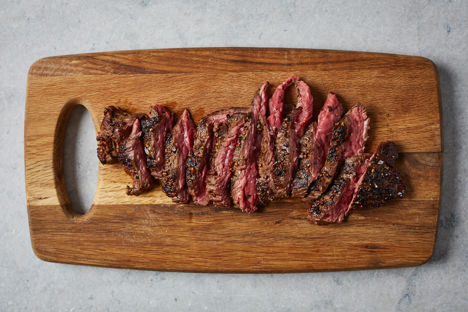Bavette steak - also known as flank steak or flap steak - is a long, flat piece of meat taken from the abdominal muscles of the cow, just below the bottom of the sirloin.
What is the difference between bavette, skirt and hanger steak?
While all three are not as valued as the primary steak cuts such as fillet, rib-eye or sirloin, these secondary cuts are much cheaper and can be just as (if not more) tasty if cooked properly. The bavette and skirt steaks, which sit further up the cow, across the ribs, can often be interchangeable as they are a similar, long, flat shape, but the bavette is the superior cut as it is slightly thicker and therefore more tender and harder to overcook. It also contains less sinew and fat. The hanger steak (or onglet) sits in between the bavette and skirt steak and shares the similar deep beefy flavour and fibrous texture.
What to look for when buying bavette
If you can find one, choose a dry-aged steak; it will be a little more expensive but has a deeper flavour. Bavette is a flat steak, but it has thicker and thinner parts – you want to choose a thicker steak where possible, so the meat isn’t so easy to overcook. It is a relatively lean cut, but will have a little marbling; this is good as it will keep the meat juicy. Fat is also an excellent carrier of flavour, so you can expect an especially ‘beefy’ flavour from this cut.
How to prepare bavette steak
Due to the fibrous nature of the cut, some treatment before cooking bavette is always a good idea. Whether this is physically, in the form of tenderising with a meat hammer or bashing with a rolling pin, or chemically in the form of a marinade, brine or rub, bavette really benefits from a bit of attention before it hits the pan.
A dry rub is advised for barbecuing. Try out a cure of equal quantities coarse salt and sugar with ground spices of your choice and some lemon for acidity. Cure for up to 12 hours, then wash off, pat dry and cook on the barbecue.
Brining the steak is well worth the time if you have it. This technique not only seasons the meat evenly all the way through, but ensures a juicy steak. You can also add ingredients such as herbs and spices to the brine for extra flavour. Learn more about brining here.
Marinating bavette also adds plenty of tailored flavour to the beef, and using acidic ingredients in your marinade such as citrus, vinegars, alcohol or even yoghurt helps to tenderise the meat.
How to cook bavette steak
The bavette comes from the abdominal muscles, meaning it is a well-worked part of the cow, and it can be tough if not treated correctly. A long, slow braise in a curry or stew gives the meat time to break down and soften. Alternatively, it should be cooked rare, then finely sliced against the grain for a tasty and tender steak; this means it lends itself well to quick cooking methods such as barbecuing or pan-frying. Slicing against the grain ensures you don’t get stringy or chewy steak, and it's perfect for sandwiches, salads or tacos. Take a look at our simple recipe below for a peppered bavette steak, then go on to browse our whole collection of bavette recipes.
How to pan-fry bavette steak
Metric
Imperial
- 1 dash of olive oil
- 400g of bavette steak
- 1 tsp black peppercorns
- 1 tsp pink peppercorns
- 1 tsp white peppercorns
- 1/2 tsp flaky sea salt
Begin by crushing the black and pink peppercorns in a pestle and mortar until coarse. Add the salt flakes in and crush a little bit more. Apply liberally to the pieces of steak and coat on both sides. Leave to cure for 1 hour
Place a large non-stick frying pan over a high heat and once the pan is smoking, add a drizzle of oil
Fry the steak for 1–3 minutes on each side, depending on the thickness
Leave to rest in a warm place for 5 minutes
Carve the steak against the grain – this is essential, otherwise you will be struggling to chew the long fibres of the steak
Stunning steak sarnies
Steak frites
You can’t beat steak and chips, and a nice bavette steak is no exception! Whether it be chunky triple-cooked chips, skinny fries, or even the cheesy polenta chips above, chips are a steak's best friend. Check out our favourite steak sauces too, to finish off this classic, crowd-pleasing dish.
Braising bavette
Bavette on the barbecue
Healthy steak salads
If you love steak but don't fancy a full-on slap-up steak dinner, pan-fried rare steak is a tasty and special salad topper. Bavette is best cooked rare, has a nice amount of texture to it and is delicious served hot or cold.
Get in touch
Please sign in or register to send a comment to Great British Chefs.


